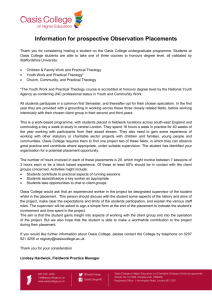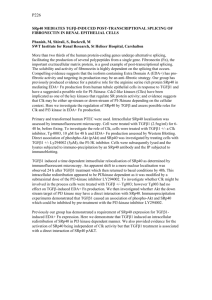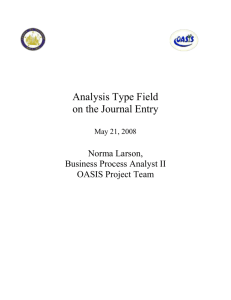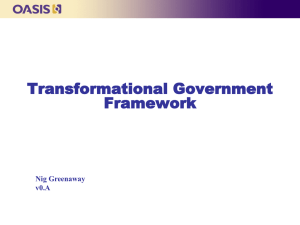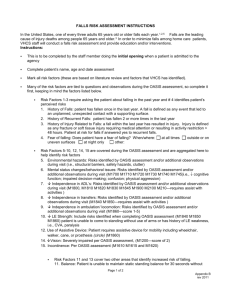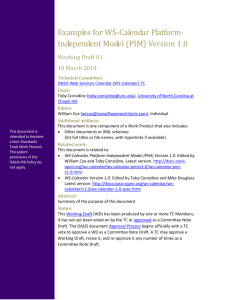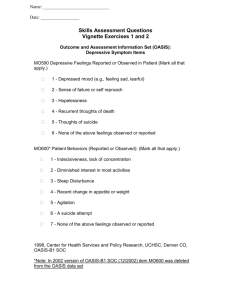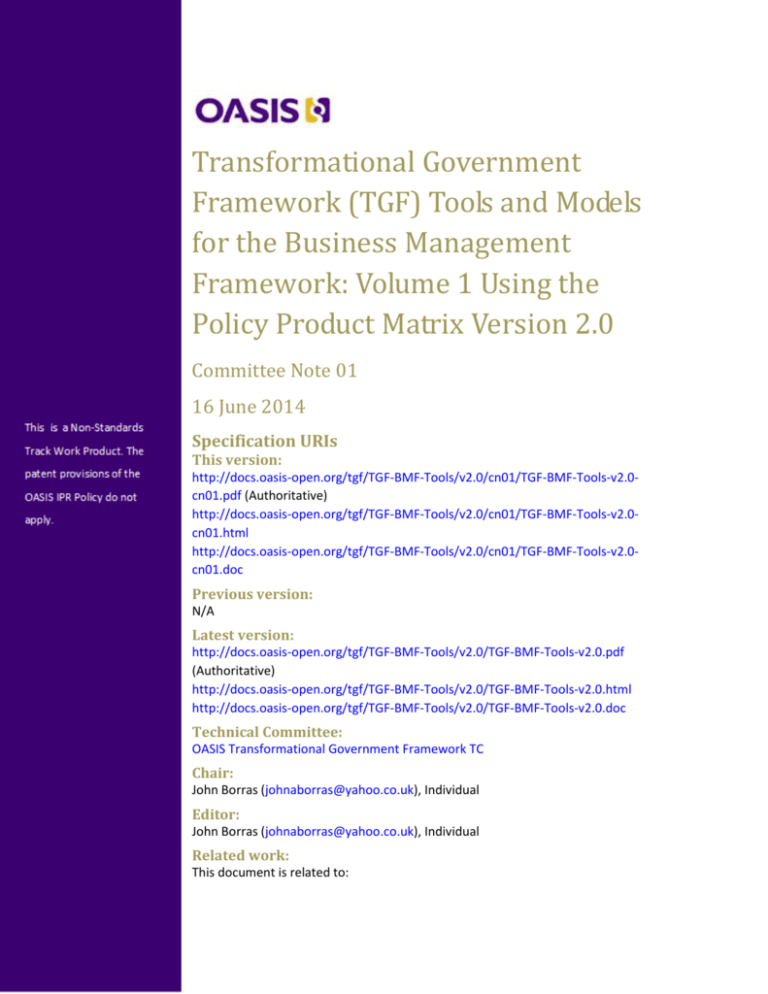
Transformational Government
Framework (TGF) Tools and Models
for the Business Management
Framework: Volume 1 Using the
Policy Product Matrix Version 2.0
Committee Note 01
16 June 2014
Specification URIs
This version:
http://docs.oasis-open.org/tgf/TGF-BMF-Tools/v2.0/cn01/TGF-BMF-Tools-v2.0cn01.pdf (Authoritative)
http://docs.oasis-open.org/tgf/TGF-BMF-Tools/v2.0/cn01/TGF-BMF-Tools-v2.0cn01.html
http://docs.oasis-open.org/tgf/TGF-BMF-Tools/v2.0/cn01/TGF-BMF-Tools-v2.0cn01.doc
Previous version:
N/A
Latest version:
http://docs.oasis-open.org/tgf/TGF-BMF-Tools/v2.0/TGF-BMF-Tools-v2.0.pdf
(Authoritative)
http://docs.oasis-open.org/tgf/TGF-BMF-Tools/v2.0/TGF-BMF-Tools-v2.0.html
http://docs.oasis-open.org/tgf/TGF-BMF-Tools/v2.0/TGF-BMF-Tools-v2.0.doc
Technical Committee:
OASIS Transformational Government Framework TC
Chair:
John Borras (johnaborras@yahoo.co.uk), Individual
Editor:
John Borras (johnaborras@yahoo.co.uk), Individual
Related work:
This document is related to:
This is a Non-Standards Track Work Product.
The patent provisions of the OASIS IPR Policy do not apply.
Transformational Government Framework Version 2.0. Edited by John Borras, Peter F
Brown, and Chris Parker. Latest version: http://docs.oasis-open.org/tgf/TGF/v2.0/TGFv2.0.html.
Abstract:
This Committee Note and the associated Wiki resource contain detailed information and
guidance on using the Policy Products matrix in the Business Management Framework, as
identified in the Transformational Government Framework (TGF) Version 2.0. It is the first in an
intended series of Committee Notes providing further guidance on the Business Management
Framework. Policy Products are the written policies, frameworks and standards which inform
government activity.
The TGF contains the following statement:
This Committee Note, together with the associated Wiki resource - https://wiki.oasisopen.org/tgf/FrontPage - sets out the range of Policy Products which should be considered in
any Transformational Government program. Not all may be necessary for every program, and in
some cases a program may wish to meet the objectives of what are shown here as separate
Policy Products through a single, broader Policy Product.
Status:
This document was last revised or approved by the OASIS Transformational Government
Framework TC on the above date. The level of approval is also listed above. Check the “Latest
version” location noted above for possible later revisions of this document.
Technical Committee members should send comments on this document to the Technical
Committee’s email list. Others should send comments to the Technical Committee by using the
“Send A Comment” button on the Technical Committee’s web page at https://www.oasisopen.org/committees/tgf/.
Citation format:
When referencing this document the following citation format should be used:
[TGF-BMF-Tools-v2.0]
Transformational Government Framework (TGF) Tools and Models for the Business Management
Framework: Volume 1 Using the Policy Product Matrix Version 2.0. Edited by John Borras. 16
June 2014. OASIS Committee Note 01. http://docs.oasis-open.org/tgf/TGF-BMFTools/v2.0/cn01/TGF-BMF-Tools-v2.0-cn01.html. Latest version: http://docs.oasisopen.org/tgf/TGF-BMF-Tools/v2.0/TGF-BMF-Tools-v2.0.html.
Copyright © OASIS Open 2014. All Rights Reserved.
TGF-BMF-Tools-v2.0-cn01
Non-Standards Track
Copyright © OASIS Open 2014. All Rights Reserved.
16 June 2014
Page 2 of 11
[Type the document title]
“A full analysis of the Policy Products which we recommend are typically needed to deliver an
effective and holistic transformation program are described in a separate TGF Committee Note
“Tools and Models for the Business Management Framework”. Although the detailed Policy
Products in that note are advisory and not all of them may be needed, any conformant
transformation program MUST use the overall framework and matrix of the Policy Product Map
in order to conduct at minimum a gap analysis aimed at identifying the key Policy Products
needed for that government, taking the Committee Note into account as guidance.”
This is a Non-Standards Track Work Product.
The patent provisions of the OASIS IPR Policy do not apply.
All capitalized terms in the following text have the meanings assigned to them in the OASIS
Intellectual Property Rights Policy (the "OASIS IPR Policy"). The full Policy may be found at the
OASIS website.
This document and translations of it may be copied and furnished to others, and derivative
works that comment on or otherwise explain it or assist in its implementation may be prepared,
copied, published, and distributed, in whole or in part, without restriction of any kind, provided
that the above copyright notice and this section are included on all such copies and derivative
works. However, this document itself may not be modified in any way, including by removing
the copyright notice or references to OASIS, except as needed for the purpose of developing any
document or deliverable produced by an OASIS Technical Committee (in which case the rules
applicable to copyrights, as set forth in the OASIS IPR Policy, must be followed) or as required to
translate it into languages other than English.
This document and the information contained herein is provided on an "AS IS" basis and OASIS
DISCLAIMS ALL WARRANTIES, EXPRESS OR IMPLIED, INCLUDING BUT NOT LIMITED TO ANY
WARRANTY THAT THE USE OF THE INFORMATION HEREIN WILL NOT INFRINGE ANY OWNERSHIP
RIGHTS OR ANY IMPLIED WARRANTIES OF MERCHANTABILITY OR FITNESS FOR A PARTICULAR
PURPOSE.
TGF-BMF-Tools-v2.0-cn01
Non-Standards Track
Copyright © OASIS Open 2014. All Rights Reserved.
16 June 2014
Page 3 of 11
[Type the document title]
The limited permissions granted above are perpetual and will not be revoked by OASIS or its
successors or assigns.
This is a Non-Standards Track Work Product.
The patent provisions of the OASIS IPR Policy do not apply.
Table of Contents
1
Policy Product Management ................................................................................................... 5
1.1 Introduction ........................................................................................................................... 5
1.2 Why Manage Policy Products? .............................................................................................. 5
1.3 The Policy Product Matrix ..................................................................................................... 6
1.4 How To Use The Policy Product Matrix ................................................................................. 7
1.5 Tips and Recommendations .................................................................................................. 8
1.6 Disclaimer .............................................................................................................................. 9
Acknowledgments ................................................................................................. 10
Appendix B.
Revision History ..................................................................................................... 11
[Type the document title]
Appendix A.
TGF-BMF-Tools-v2.0-cn01
Non-Standards Track
Copyright © OASIS Open 2014. All Rights Reserved.
16 June 2014
Page 4 of 11
This is a Non-Standards Track Work Product.
The patent provisions of the OASIS IPR Policy do not apply.
1 Policy Product Management
1.1 Introduction
This Committee Note, together with the associated Wiki resource - http://wiki.oasisopen.org/tgf/FrontPage, contains detailed information and guidance on using the Policy
Products matrix in the Business Management Framework, as identified in the Transformational
Government Framework (TGF) version 2.0.
The TGF contains the following statement:
The Wiki resource, http://wiki.oasis-open.org/tgf/FrontPage, sets out the range of Policy
Products which should be considered in any Transformational Government program. Not all may
be necessary for every program, and in some cases a program may wish to meet the objectives
of what are shown here as separate Policy Products through a single, broader Policy Product.
1.2 Why Manage Policy Products?
Traditional policy approaches to e-government have often been narrowly focused. An effective
Transformational Government program that attempts to join-up service delivery across a
number of different agencies requires a more holistic approach to policy development and this
necessitates a much broader range of policy products. We define a Policy Product in the
Transformational Government Framework (TGF) as any “document that has been formally
adopted on a government-wide basis and aimed at helping achieve one or other goal of
transformational government”. These documents vary in nature (from statutory documents
with legal force, through mandated policies, to informal guidance and best practice) and in
length (some may be very lengthy documents; others just a few paragraphs of text). Policy
Products are important drivers of change within government: first because the process of
producing them, if managed effectively, can help ensure strategic clarity and stakeholder buy-in;
and second because they then become vital communication and management tools.
Over recent years, several governments have published a wide range of Policy Products as part
of their work on Interoperability Frameworks and Enterprise Architectures, and other
governments are therefore able to draw on these as reference models when developing their
own Policy Products. However, we believe that the set of Policy Products required to ensure
that a holistic, government -wide vision for transformation can be delivered is much broader
than is currently being addressed in most Interoperability Frameworks and Enterprise
Architectures.
TGF-BMF-Tools-v2.0-cn01
Non-Standards Track
Copyright © OASIS Open 2014. All Rights Reserved.
16 June 2014
Page 5 of 11
[Type the document title]
“A full analysis of the Policy Products which we recommend are typically needed to deliver an
effective and holistic transformation program are described in a separate TGF Committee Note
“Tools and Models for the Business Management Framework”. Although the detailed Policy
Products in that note are advisory and not all of them may be needed, any conformant
transformation program MUST use the overall framework and matrix of the Policy Product Map
in order to conduct at minimum a gap analysis aimed at identifying the key Policy Products
needed for that government, taking the Committee Note into account as guidance.”
This is a Non-Standards Track Work Product.
The patent provisions of the OASIS IPR Policy do not apply.
1.3 The Policy Product Matrix
[Type the document title]
As detailed in the TGF v2.0, a TGF-conformant program must use the matrix shown below in
order to create a map of the Policy Products needed to deliver the program effectively. This
matrix maps the three delivery processes described in the TGF (Business Management including
Benefits Realization, Service Management and Technology and Digital Asset Management)
against the five interoperability levels identified in what is currently the broadest of
Interoperability Frameworks - the European Interoperability Framework version 2.0 (EIFv2 ) –
see Figure 1 below.
F IGURE 1: EIF V 2 I NTEROPERABILITY LEVELS (Note MS in this diagram means Member States of the
European Union)
While the EIFv2 framework is conceptually complete, by mapping it against the core delivery
processes, a much clearer sense can be gained of the specific actions that are needed in each
area of policy.
Figure 2 below shows the Policy Product Matrix with illustrative examples in each cell of the
product types that are applicable for each domain. The full list of the policy product types for
each cell, and a high-level summary of all product types, are available on the TGF TC Wiki at
http://wiki.oasis-open.org/tgf/FrontPage and the TC is making best efforts to keep the list under
constant review and up-to-date. Proposals for changes to any of the cell entries or for new
entries can be made by non-members using the “Send a Comment” facility on the TC Homepage
- http://www.oasis-open.org/committees/tc_home.php?wg_abbrev=tgf
TGF-BMF-Tools-v2.0-cn01
Non-Standards Track
Copyright © OASIS Open 2014. All Rights Reserved.
16 June 2014
Page 6 of 11
This is a Non-Standards Track Work Product.
The patent provisions of the OASIS IPR Policy do not apply.
Interoperability Levels
Political
Legal
Business Case.
Business
Management
Service
Management
Risk
Management
Strategy.
Transformational
Operating
Model.
Legal
authority for
inter-agency
collaboration.
Customer
Identity
Management
Strategy.
eSignatures
and eBusiness
enabling
legislation.
Privacy and Data
Sharing Policy
Privacy, data
protection
and data
security
legislation.
Channel
Transformation
Policy.
Digital Inclusion
Strategy.
ICT Strategy.
Technology
and Digital
Asset
Management
Legal
framework for
public private
partnership.
Organizational
Asset Register.
Collaborative
stakeholder
engagement
model.
Semantic
Technical
Business
Process
Model.
Information
Preservation
Framework.
Logical Data
Model.
Technology
Roadmap.
Key services
portfolio.
Metadata
Management
Policy.
Crossgovernment
Customer
Segmentation
Framework.
Common Data
Standards.
Accessibility
Guidelines.
Service
definition for
one stop
services.
Single Sign-on
Architecture.
Presentation
Architecture.
Marketing and
Communication
s Strategy.
Channel
Management
Framework.
Cloud Strategy.
Framework
Contracts.
Compliance
Procedures.
Open Source
Policy.
Procurement
Legislation.
Service Level
Agreements.
Data Locator.
Physical Data
Model.
Supplier
Management
Guidelines.
Interop’bility
Framework.
Security
Architecture.
ServiceOriented
Architecture.
F IGURE 2: POLICY P RODUCT MATRIX with illustrative examples
1.4 How To Use The Policy Product Matrix
Each policy product type listed in the matrix is accompanied by a definition of the product
together with a description of the issue that the product is intended to address. This is followed
by examples of specific policy products in use around the world that represent current good
practice and further guidance notes for each product type. See Figure 3 below as a
representative example of a typical cell entry.
Cell “Business Management/Political”
Policy Product Type - TRANSFORMATIONAL OPERATING MODEL
Description
The strategy for ensuring that the intended benefits
from the TG program are delivered in practice.
TGF-BMF-Tools-v2.0-cn01
Non-Standards Track
Problem Addressed
Target Operating Model
Copyright © OASIS Open 2014. All Rights Reserved.
16 June 2014
Page 7 of 11
[Type the document title]
Delivery
Processes
This is a Non-Standards Track Work Product.
The patent provisions of the OASIS IPR Policy do not apply.
Example(s) of current Policy Product of this type:
UK - http://digital.cabinetoffice.gov.uk/
Notes See TGF Pattern [B3] Transformational Operating Model
See also New South Wales, Australia - http://www.egov.vic.gov.au/trends-and-issues/citizencentric-service/transforming-the-citizen-experience-one-stop-shop-for-public-services-in-pdfformat-1081kb.html?utm_source=newsletter&utm_medium=email&utm_campaign=aug2012news
F IGURE 3: POLICY P RODUCT TYPE – FOR ILLUSTRATIVE PURPOSES ONLY
The policy products listed in the various levels of the matrix reflect the generally accepted lifecycle of public sector strategic planning, ie Vision PolicyStrategyImplementation Plans
Operation. Hence there are instances of policies and strategies in the upper levels and these
flow down to the plans and tools for their implementation in the lower levels. Whilst this may
perhaps be regarded as unnecessary duplication, it does allow for an audit trail to be established
ensuring that political objectives are being delivered and the goals being are realized.
Adopters of the TGF should:
review the range of their own policy products;
compare them against the types and examples in the full matrix contained in the online
resource at - http://wiki.oasis-open.org/tgf/FrontPage,;
determine the applicability of the product types and examples and, where necessary,
initiate a process to elaborate local policy products for their respective jurisdiction.
1.5 Tips and Recommendations
This is not intended to be a bureaucratic, box-ticking exercise. Rather, the Policy Product Matrix
is intended as a pragmatic tool to help governments think through the policy landscape which a
Transformational Government Program needs to operate within and to make an impact on.
Policy Products may not be needed for every policy product in every Transformational
Government Program. For example where the service delivery is being provided by a Cloud
provider then the responsibility for some aspects and the associated policy products will lie with
the Cloud provider and not the program leadership. Also, some objectives of a specific program
may be met with a single Policy Product covering two or more separate Policy Product types (for
example, by combining the Risk Management Strategy into Benefits Realisation).
In practical terms, we recommend:
Use the Policy Product Matrix during the early days of establishing a Transformational
Government program:
as an assessment tool to help identify all relevant existing or planned policy activity
which impacts on the objectives of the program;
as a framework for gap analysis, helping to identify key policy issues for the program
which are currently not being addressed.
TGF-BMF-Tools-v2.0-cn01
Non-Standards Track
Copyright © OASIS Open 2014. All Rights Reserved.
16 June 2014
Page 8 of 11
[Type the document title]
For each cell of the matrix, it is only realistic to set down a minimum set of policy product types
because the list will almost certainly evolve and expand over time and also local
implementations may find the need for other products to suit their local circumstances.
This is a Non-Standards Track Work Product.
The patent provisions of the OASIS IPR Policy do not apply.
Build a Transformational Government policy community as an on-going activity and ensure
that:
all relevant policy work is seen as part of a connected whole;
there is effective visibility and engagement between the people and teams working on
different but related Policy Products.
Where a single agency wishes to implement a Transformational Government delivery
model, and that approach does not involve joining-up service delivery with other agencies,
then a more selective use of the whole matrix would be appropriate.
1.6 Disclaimer
It should also be recognized that Governments do not always openly publish all of their policy
products, and this explains why some of the cells in the matrix do not show any examples when
in fact they do exist rather than there being no examples.
TGF-BMF-Tools-v2.0-cn01
Non-Standards Track
Copyright © OASIS Open 2014. All Rights Reserved.
16 June 2014
Page 9 of 11
[Type the document title]
Each cell in the matrix on the online Wiki resource contains examples of policy product types
that the TGF Technical Committee considers to be good practice to have as part of a TGF
compliant program as well as examples of Policy Products for each type. The examples include
URLs pointing to material contained on external websites, but the persistence of which cannot
be guaranteed. The TC will make every effort to keep this information up to date on the Wiki
but readers may need to conduct further research if the links do not work or the referenced
material is no longer available.
This is a Non-Standards Track Work Product.
The patent provisions of the OASIS IPR Policy do not apply.
Appendix A. Acknowledgments
The following individuals have participated in the creation of this Committee Note and are
gratefully acknowledged:
Participants:
[Type the document title]
Hans A. Kielland Aanesen, Individual Member
Oliver Bell, Microsoft Corporation
John Borras, Individual Member
Peter F Brown, Individual Member
Nig Greenaway, Fujitsu Ltd
Gershon Janssen, Individual Member
Jenny Huang, iFOSS Foundation
Chris Parker, CS Transform Ltd
Colin Wallis, New Zealand Government
Joe Wheeler, MTG Management Consultants, LLC
Mark Woodward, Individual Member
TGF-BMF-Tools-v2.0-cn01
Non-Standards Track
Copyright © OASIS Open 2014. All Rights Reserved.
16 June 2014
Page 10 of 11
This is a Non-Standards Track Work Product.
The patent provisions of the OASIS IPR Policy do not apply.
Appendix B. Revision History
Revision
9 Jan 2014
Editor
John Borras
Changes Made
Initial draft to bring the CN into line with
the new TGF v2.0
[Type the document title]
01
Date
TGF-BMF-Tools-v2.0-cn01
Non-Standards Track
Copyright © OASIS Open 2014. All Rights Reserved.
16 June 2014
Page 11 of 11


